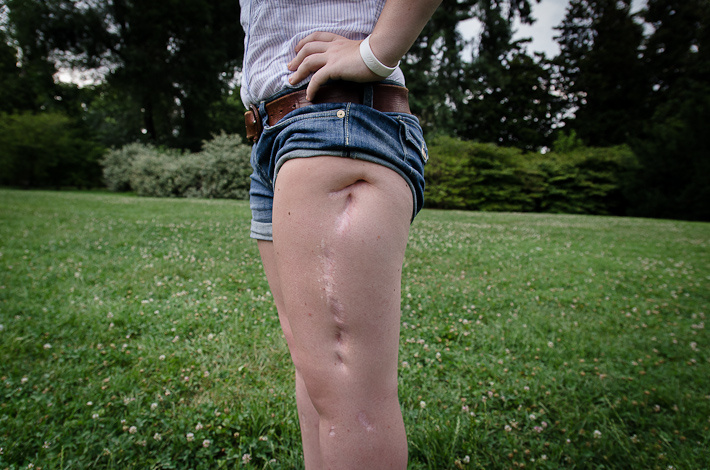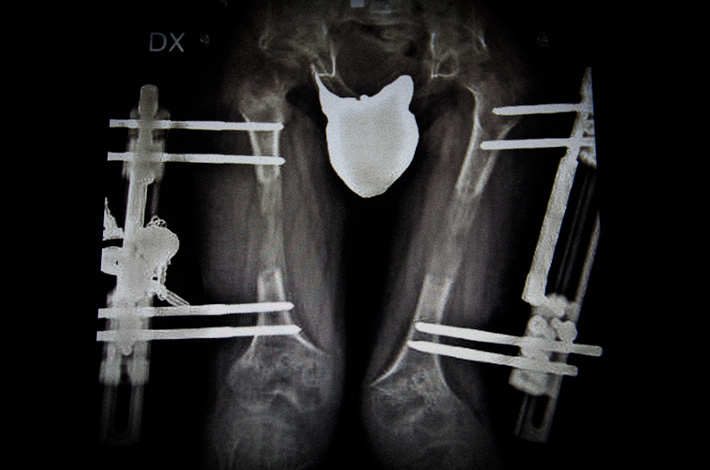Achondroplasia is a form of dwarfism caused by a genetic mutation, affecting one in 20,000 people. In Italy there are about 2,500 people living with achondroplasia. Unlike with other countries, where it's the society that tends to adapt to people of short stature, in Italy it's the dwarfs who must adapt to the society, through a procedure called surgical lengthening. This is a long and painful treatment that consists of breaking bones and applying a fixer, to be lengthened by 1mm per day. On average, a person affected with achondroplasia is about 1.30m high. Thanks to the surgical lengthening of the lower limbs (femur by about 10cm, tibia by about 10cm), that person can reach a height of about 1,50 to 1,55m. The best age to begin the treatment is between 12 and 16 years old. The treatment lasts about three years.
Annons
All this information got a little bit too much for me, so I got in touch with Emanuele Satolli, an Italian photographer who has been documenting achondroplasia sufferers undergoing treatment.
VICE: So how long were you working on this project?
Emanuele Satolli: I started in January 2012. I realised that I never met any people with dwarfism in Milan, in the streets or the clubs, so I wondered - where are they? I started looking into it and spoke with the president of AISAC (Association for Information and Study of the Achondroplasia), and he told me that in Italy they have to fit into society more than in other countries where society often changes to accept them. He said that there is also a popular lengthening procedure. Which I found really interesting. I looked further into it and it turns out that in Italy around 90% of people with achondroplasia undergo this surgery, while in the rest of Europe it's something like 8%.
VICE: So how long were you working on this project?
Emanuele Satolli: I started in January 2012. I realised that I never met any people with dwarfism in Milan, in the streets or the clubs, so I wondered - where are they? I started looking into it and spoke with the president of AISAC (Association for Information and Study of the Achondroplasia), and he told me that in Italy they have to fit into society more than in other countries where society often changes to accept them. He said that there is also a popular lengthening procedure. Which I found really interesting. I looked further into it and it turns out that in Italy around 90% of people with achondroplasia undergo this surgery, while in the rest of Europe it's something like 8%.

What is it about life in Italy that makes this surgery so popular?
Well that’s what I was wondering. It’s a very long and painful treatment, but there are also psychological issues involved. These people who feel that they have to change their body because they are wrong, or they need to fit into a society that doesn't take their needs into account; It's a very interesting thing to look at. When I met the people undergoing the treatment, all of them were very satisfied with it. They all felt that they had done the right thing, and also that the jobs or successes that they now have can be attributed, at least partly, to the surgery. I think that they are right; They did benefit from this because they felt more accepted into our society. However in other countries they could be happy without this surgery. So in Italy it's harder for dwarves to exist without this surgery?
Yes - of course. Without the surgery it’s very hard for them to live a normal life. What other explanation can there be for 90% of achondroplasia cases opting for lengthening? If you look at the United States, or other European countries, the percentages are much smaller. It is only in Spain that you get a comparatively high number of lengthening surgeries, but still nowhere near Italy’s rates. Also when parents talk to the doctors after birth, the doctors just say: "Don't worry, when he or she is 13 years old, he or she can have lengthening surgery and everything will be fine." It’s a cultural approach from the beginning.
Well that’s what I was wondering. It’s a very long and painful treatment, but there are also psychological issues involved. These people who feel that they have to change their body because they are wrong, or they need to fit into a society that doesn't take their needs into account; It's a very interesting thing to look at. When I met the people undergoing the treatment, all of them were very satisfied with it. They all felt that they had done the right thing, and also that the jobs or successes that they now have can be attributed, at least partly, to the surgery. I think that they are right; They did benefit from this because they felt more accepted into our society. However in other countries they could be happy without this surgery. So in Italy it's harder for dwarves to exist without this surgery?
Yes - of course. Without the surgery it’s very hard for them to live a normal life. What other explanation can there be for 90% of achondroplasia cases opting for lengthening? If you look at the United States, or other European countries, the percentages are much smaller. It is only in Spain that you get a comparatively high number of lengthening surgeries, but still nowhere near Italy’s rates. Also when parents talk to the doctors after birth, the doctors just say: "Don't worry, when he or she is 13 years old, he or she can have lengthening surgery and everything will be fine." It’s a cultural approach from the beginning.
Annons

Did you meet anyone who was unhappy after having the surgery?
No. Everybody was happy. I mean, even basic daily things like taking the subway were hard for them before, they lacked independence. This one guy I met during his treatment – a few weeks after the femur surgery – was in a lot of pain but he was happy. He knew he had to undergo more surgery but was still very excited about becoming independent. What are the costs of this surgery?
Well in Italy the government covers almost all the costs of the surgery. But the costs of the extensive physiotherapy fall on the patient. For the femur surgery, the tibia and the arms, you are recommended one year of physiotherapy. Also, the main centers for this surgery are Milan and Genoa, so obviously people with achondroplasia from the South, for instance, must travel there with their families and stay for some time – so the cost is still considerable.
No. Everybody was happy. I mean, even basic daily things like taking the subway were hard for them before, they lacked independence. This one guy I met during his treatment – a few weeks after the femur surgery – was in a lot of pain but he was happy. He knew he had to undergo more surgery but was still very excited about becoming independent. What are the costs of this surgery?
Well in Italy the government covers almost all the costs of the surgery. But the costs of the extensive physiotherapy fall on the patient. For the femur surgery, the tibia and the arms, you are recommended one year of physiotherapy. Also, the main centers for this surgery are Milan and Genoa, so obviously people with achondroplasia from the South, for instance, must travel there with their families and stay for some time – so the cost is still considerable.

Do you plan to follow up with these people you met?
Yes – I hope to do so. Especially with some of the younger people I met, who were just at the beginning of their treatments.
Was there any reticence about being involved in the photo story?
Not really – most were happy to be involved. Many told me they decided to be involved in order to promote AISAC or to encourage knowledge of the problems they have in Italy and to build wider awareness of achondroplasia.See more of Emanuele's work here.
Annons
Did you find this strange? Check out our film about a guy that injects himself with snake venom, here.More on the strange things people are willing to do to their bodies:Japanese BagelheadsI Got Fred from Spector Tattooed on My NeckPee in My Mouth
